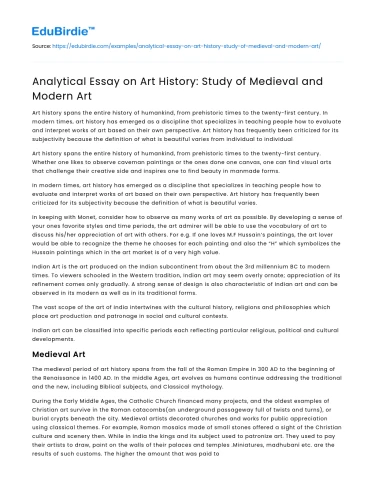Art history spans the entire history of humankind, from prehistoric times to the twenty-first century. In modern times, art history has emerged as a discipline that specializes in teaching people how to evaluate and interpret works of art based on their own perspective. Art history has frequently been criticized for its subjectivity because the definition of what is beautiful varies from individual to individual
Art history spans the entire history of humankind, from prehistoric times to the twenty-first century. Whether one likes to observe caveman paintings or the ones done one canvas, one can find visual arts that challenge their creative side and inspires one to find beauty in manmade forms.
Save your time!
We can take care of your essay
- Proper editing and formatting
- Free revision, title page, and bibliography
- Flexible prices and money-back guarantee
In modern times, art history has emerged as a discipline that specializes in teaching people how to evaluate and interpret works of art based on their own perspective. Art history has frequently been criticized for its subjectivity because the definition of what is beautiful varies.
In keeping with Monet, consider how to observe as many works of art as possible. By developing a sense of your ones favorite styles and time periods, the art admirer will be able to use the vocabulary of art to discuss his/her appreciation of art with others. For e.g. If one loves M.F Hussain’s paintings, the art lover would be able to recognize the theme he chooses for each painting and also the “H” which symbolizes the Hussain paintings which in the art market is of a very high value.
Indian Art is the art produced on the Indian subcontinent from about the 3rd millennium BC to modern times. To viewers schooled in the Western tradition, Indian art may seem overly ornate; appreciation of its refinement comes only gradually. A strong sense of design is also characteristic of Indian art and can be observed in its modern as well as in its traditional forms.
The vast scope of the art of India intertwines with the cultural history, religions and philosophies which place art production and patronage in social and cultural contexts.
Indian art can be classified into specific periods each reflecting particular religious, political and cultural developments.
Medieval Art
The medieval period of art history spans from the fall of the Roman Empire in 300 AD to the beginning of the Renaissance in 1400 AD. In the middle Ages, art evolves as humans continue addressing the traditional and the new, including Biblical subjects, and Classical mythology.
During the Early Middle Ages, the Catholic Church financed many projects, and the oldest examples of Christian art survive in the Roman catacombs(an underground passageway full of twists and turns), or burial crypts beneath the city. Medieval artists decorated churches and works for public appreciation using classical themes. For example, Roman mosaics made of small stones offered a sight of the Christian culture and scenery then. While in India the kings and its subject used to patronize art. They used to pay their artists to draw, paint on the walls of their palaces and temples .Miniatures, madhubani etc. are the results of such customs. The higher the amount that was paid to the artist finer was the stone carving.
Modern Art
Consider the term “Modern Art.” Art historians have observed that artists of earlier times also perceived themselves as modern. Renaissance humanists thought they were revolutionaries in the 15th century. Modern Art refers to art created roughly between 1867 and 1975. Major movements included Impressionism, Cubism, Surrealism, Abstract Expressionism, and Pop Art. To human eyes, Modern pieces reflect change, including technological, social, scientific, and political changes. This period also included the emergence of modern governments.For two decades, French painters and other artists studied the way light changes as you create a landscape or another scene. Early in the 1900s, Picasso, Braque, Dali, and Miro, continued the progression towards abstract art. For example, Pablo Picasso, a founder of Cubism, demonstrated how geometry can express the depth of forms like the female body and drapery in The Dance of the Veils in 1907. American artists reflected the influence of Cubism and Surrealism. Their painting also shows that strong lines are used in Modern Art when needed to express a concept.
Later in the twentieth century, artists like Jackson Pollock painted with a new emotional style in Abstract Expressionism. In One: Number 31, 1950, Pollock used the paint spatter technique with acrylic to create a vivid abstract composition of white, black, and grey on tan canvas. As the U.S. entered the 1960s, Andy Warhol embodied the plastic nature of popular culture with commercial art. He famously used celebrities and commercial items like Campbell’s soup cans to create art that reflected his time.
At the same time in India artists like M.F.Hussain, Tyeb Mehta, Raza, Souza etc. studied fine art in the JJ Schools of art which was built by the Britishers during the pre-independence period. M.F.Hussain painted with his own unique thoughts through the semi-abstract form of art.However even then the paintings were only picked up by the Britishers and the rich class of the society. Other artists,Tyeb Mehta,raza,souza went to London to polish their skills in fine art.Their painting has an influence of the British culture. Yet they paintings were not able to be considered as an investment by many. As their names grew their paintings began to fetch higher amounts and people realized the importance to art as an investment.






 Stuck on your essay?
Stuck on your essay?

